人教版(2019)选择性必修 第三册Unit 1 Art Video Time 课件(共32张PPT)
文档属性
| 名称 | 人教版(2019)选择性必修 第三册Unit 1 Art Video Time 课件(共32张PPT) |

|
|
| 格式 | pptx | ||
| 文件大小 | 59.2MB | ||
| 资源类型 | 教案 | ||
| 版本资源 | 人教版(2019) | ||
| 科目 | 英语 | ||
| 更新时间 | 2024-04-08 19:40:27 | ||
图片预览

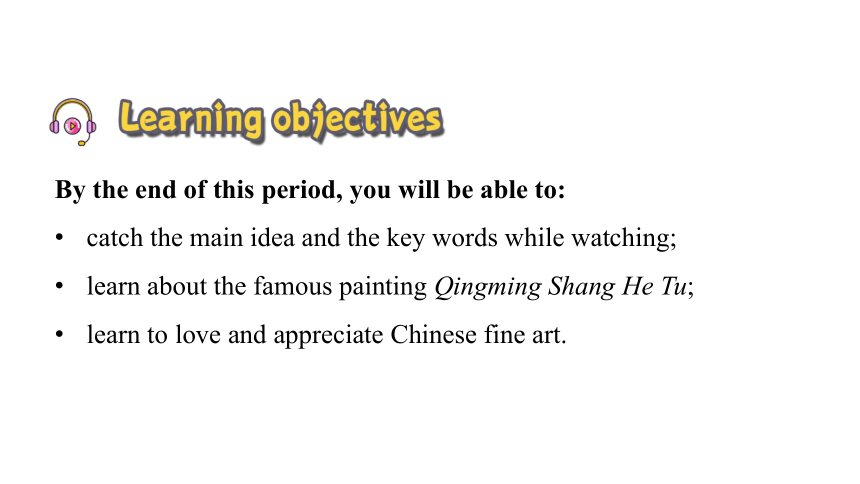
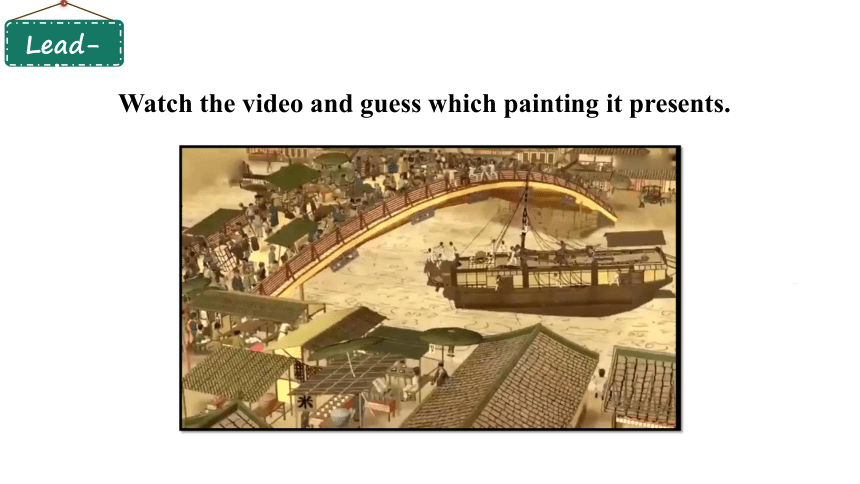
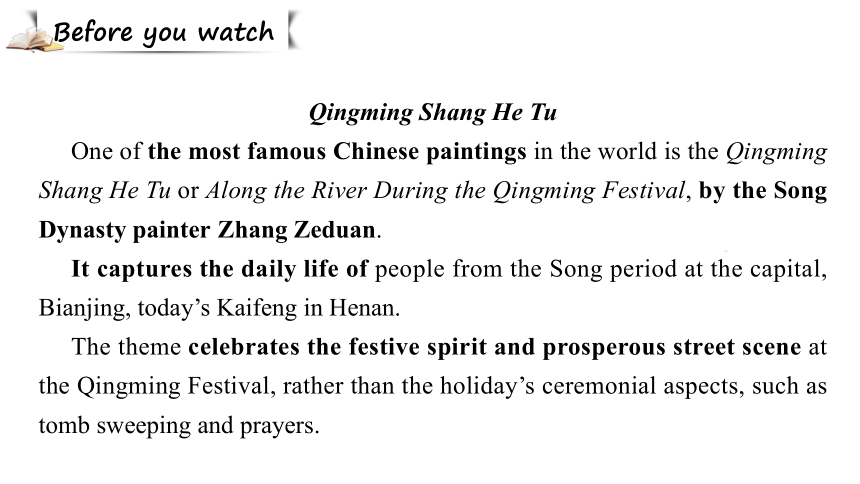
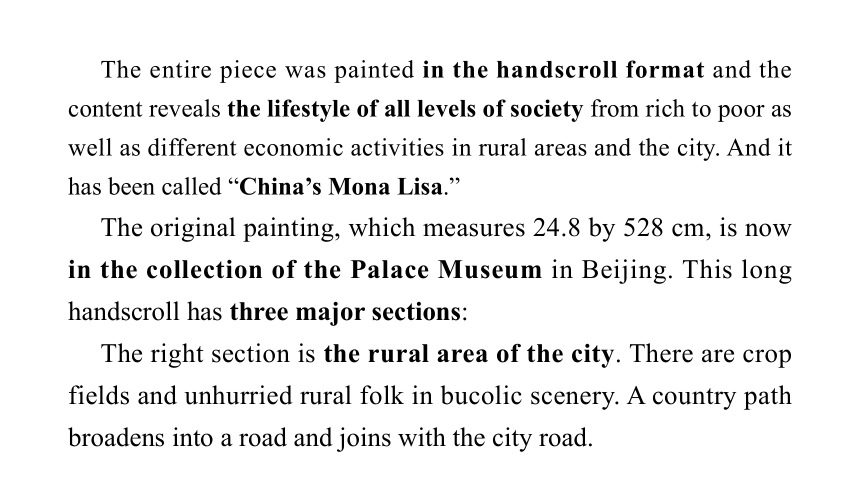
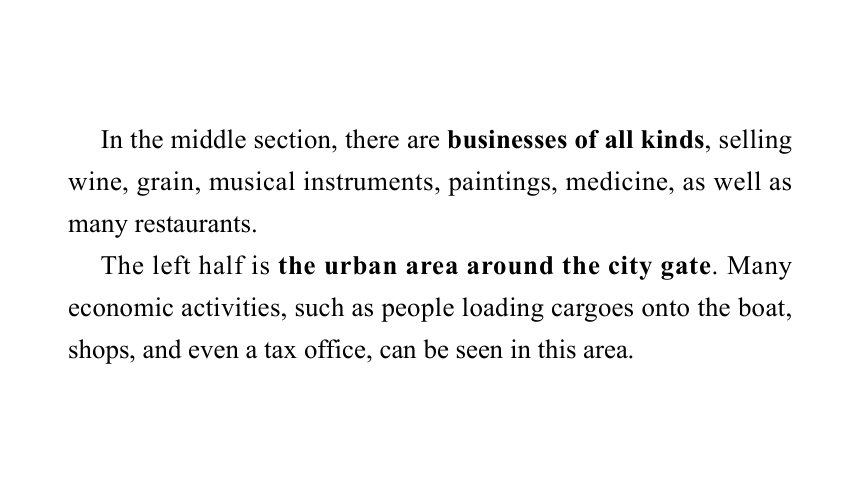
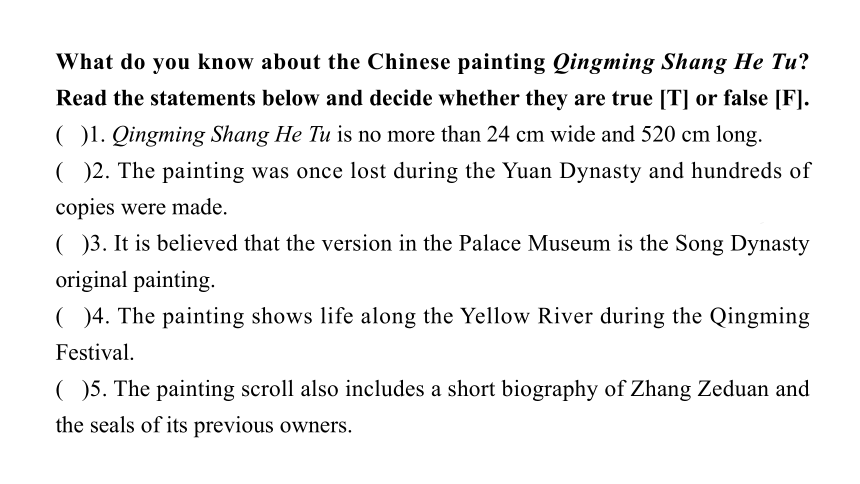

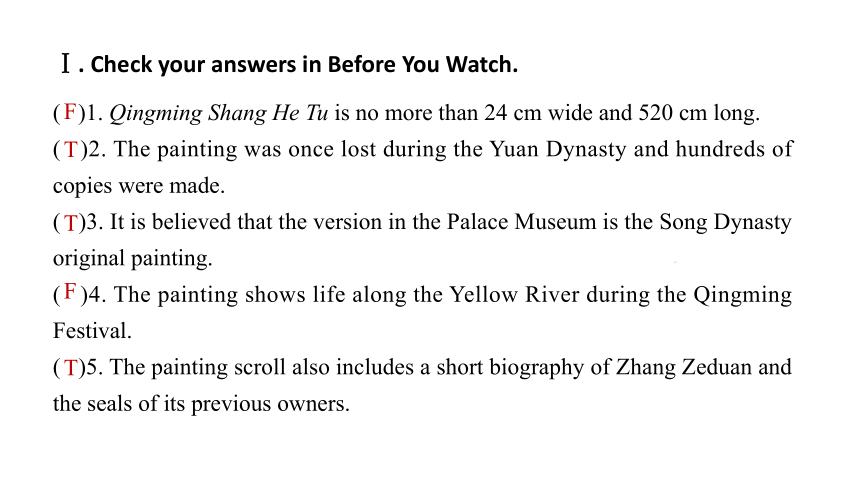
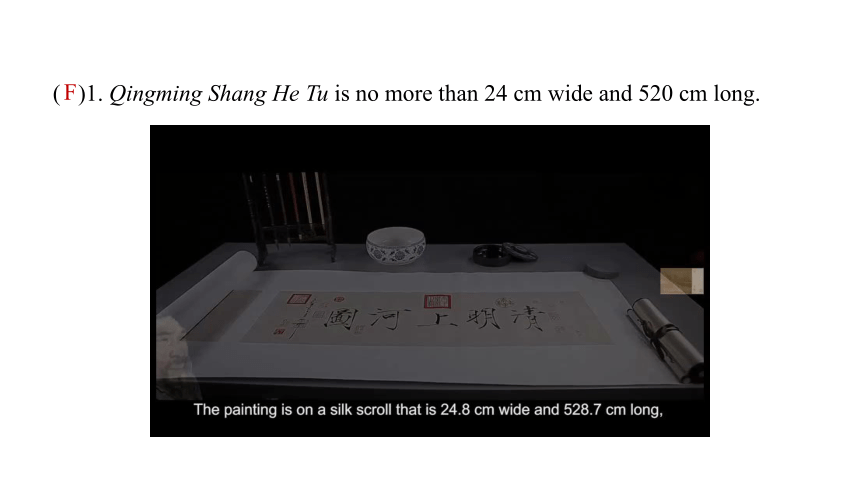
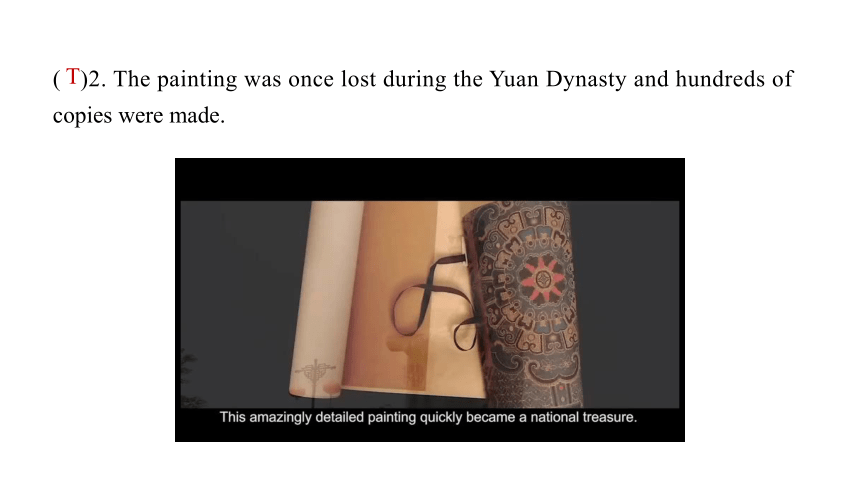
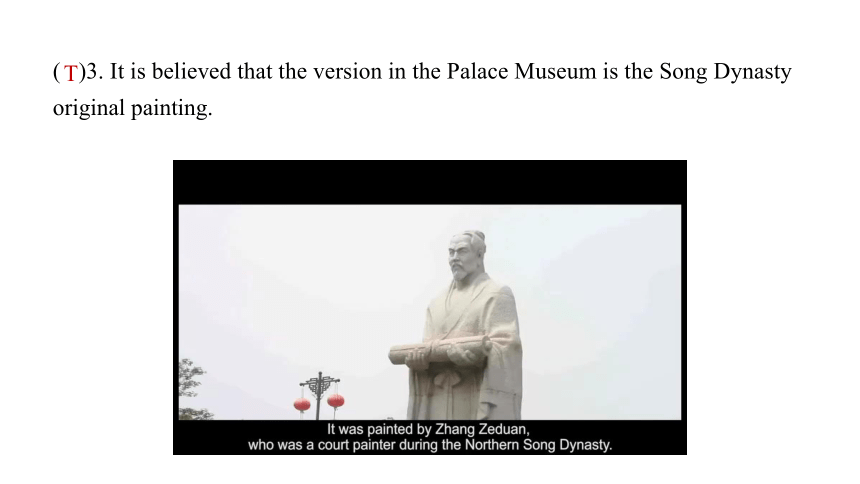
文档简介
(共32张PPT)
Unit 1
Art
Video Time
By the end of this period, you will be able to:
catch the main idea and the key words while watching;
learn about the famous painting Qingming Shang He Tu;
learn to love and appreciate Chinese fine art.
Lead-in
Watch the video and guess which painting it presents.
Before you watch
Qingming Shang He Tu
One of the most famous Chinese paintings in the world is the Qingming Shang He Tu or Along the River During the Qingming Festival, by the Song Dynasty painter Zhang Zeduan.
It captures the daily life of people from the Song period at the capital, Bianjing, today’s Kaifeng in Henan.
The theme celebrates the festive spirit and prosperous street scene at the Qingming Festival, rather than the holiday’s ceremonial aspects, such as tomb sweeping and prayers.
The entire piece was painted in the handscroll format and the content reveals the lifestyle of all levels of society from rich to poor as well as different economic activities in rural areas and the city. And it has been called “China’s Mona Lisa.”
The original painting, which measures 24.8 by 528 cm, is now in the collection of the Palace Museum in Beijing. This long handscroll has three major sections:
The right section is the rural area of the city. There are crop fields and unhurried rural folk in bucolic scenery. A country path broadens into a road and joins with the city road.
In the middle section, there are businesses of all kinds, selling wine, grain, musical instruments, paintings, medicine, as well as many restaurants.
The left half is the urban area around the city gate. Many economic activities, such as people loading cargoes onto the boat, shops, and even a tax office, can be seen in this area.
What do you know about the Chinese painting Qingming Shang He Tu Read the statements below and decide whether they are true [T] or false [F].
( )1. Qingming Shang He Tu is no more than 24 cm wide and 520 cm long.
( )2. The painting was once lost during the Yuan Dynasty and hundreds of copies were made.
( )3. It is believed that the version in the Palace Museum is the Song Dynasty original painting.
( )4. The painting shows life along the Yellow River during the Qingming Festival.
( )5. The painting scroll also includes a short biography of Zhang Zeduan and the seals of its previous owners.
While you watch
( )1. Qingming Shang He Tu is no more than 24 cm wide and 520 cm long.
( )2. The painting was once lost during the Yuan Dynasty and hundreds of copies were made.
( )3. It is believed that the version in the Palace Museum is the Song Dynasty original painting.
( )4. The painting shows life along the Yellow River during the Qingming Festival.
( )5. The painting scroll also includes a short biography of Zhang Zeduan and the seals of its previous owners.
F
T
T
T
F
Ⅰ. Check your answers in Before You Watch.
( )1. Qingming Shang He Tu is no more than 24 cm wide and 520 cm long.
F
( )2. The painting was once lost during the Yuan Dynasty and hundreds of copies were made.
T
( )3. It is believed that the version in the Palace Museum is the Song Dynasty original painting.
T
( )4. The painting shows life along the Yellow River during the Qingming Festival.
F
( )5. The painting scroll also includes a short biography of Zhang Zeduan and the seals of its previous owners.
T
Ⅱ.Take notes about the details that are displayed in the painting.
Left
The city The first city gate The roads leading to the city
Right
The Rainbow Bridge The road and the river The countryside
Left
The city The first city gate The roads leading to the city
butcher shops
doctor’s clinics
hotels
inns
houses
fabric shops
a line of camels carrying goods
temples
inns
large houses
people traveling on foot,and in carts and sedan chairs
Right
The Rainbow Bridge The road and the river The countryside
arching over the river
people selling food and drink on both sides
travelers passing by
packed with restaurants
full of boats
a few houses
a few travelers
butcher shops, doctor’s clinics, hotels, inns, houses, fabric shops
a line of camels carrying goods
The city and the first city gate
The roads leading to the city
temples, inns, large houses, people traveling on foot,
and in carts and sedan chairs
The Rainbow Bridge
arching over the river, people selling food and drink on both sides,
travelers passing by
The road and the river
packed with restaurants full of boats
The countryside
a few houses a few travelers
Read together
Qingming Shang He Tu
No doubt,one of the most admired Chinese paintings of all time is the Qingming Shang He Tu, or Along the River During the Qingming Festival. The painting is on a silk scroll that is 24.8 cm wide and 528.7 cm long, bearing Emperor HuiZong's name. It was painted by Zhang Zeduan, who was a court painter during the Northern Song Dynasty.
This amazingly detailed painting quickly became a national treasure. Over the centuries that followed, hundreds of copies of it were made, many of which became national treasures themselves. Although the original painting was lost for some time, it is now proudly placed in the Palace Museum in Beijing.
The painting is exhibited for only brief periods every few years. However, using computer animation, the painting has been remade into an animated digital version for all to enjoy. It contains moving characters and objects, showing life along the Bian River during the Qingming Festival, a time when Chinese people visit their ancestors’ graves.
Flowing from right to left, the painting begins by showing the countryside outside Bianjing City, the capital of China at that time. There are a few houses and a few people travelling back to Bianjing. The scene soon becomes more crowded. The road beside the river becomes packed with restaurants, and the river becomes full of boats. Then we see the Rainbow Bridge arching over the river. On both sides of the bridge are people selling food and drink, while travelers pass by. Soon, the city begins to emerge. We see temple, inns and large houses. The roads are now filled with people travelling on foot, and in carts and sedan chairs. Then we come to the first city gate. Through the gate is passing a line of camels carrying goods. In the city, there are butcher shops, doctor’s clinics, hotels, inns, houses, and fabric shops. The streets are still crowded with people, but most of them are relaxing and taking it easy.
The painting ends here, but the scroll does not. About half of the scroll has the seals of it’s previous owners, along with poems praising the painting’s beauty. There is also a note which gives a short biography of Zhang Zeduan. These seals and poems, along with the note, are the reasons why many experts claim this to be the original painting.
The Qingming Shang He Tu is not only a true work of art, but it also gives us a rare insight into daily life in ancient China. So often, history only contains the stories of emperors, generals, and important events. This painting’s great appeal is that it provides us with a look into ordinary people's lives in the Song Dynasty.
After you watch
1. What does the following statement mean: “This painting’s great appeal is that it provides us with a look into ordinary people’s lives in the Song Dynasty” Who do you think the painting is most appealing to
This statement means that the reason why the painting is so appealing is because it gives us, in the modern world, a snapshot of an everyday moment in the distant past. I think the painting is most appealing to people interested in our history, society, and culture.
2. Do you know of any other paintings like this one
10,000 Miles Along the Yangzi River, created by the artist, Wang Hui, is a similar painting. It is a 53-foot-long scroll showing the length of the Yangzi River with references to China’s culture and traditions.
Surf on the Internet for more information about Chinese famous paintings. Choose one and make an introduction in 80 words.
Homework
Unit 1
Art
Video Time
By the end of this period, you will be able to:
catch the main idea and the key words while watching;
learn about the famous painting Qingming Shang He Tu;
learn to love and appreciate Chinese fine art.
Lead-in
Watch the video and guess which painting it presents.
Before you watch
Qingming Shang He Tu
One of the most famous Chinese paintings in the world is the Qingming Shang He Tu or Along the River During the Qingming Festival, by the Song Dynasty painter Zhang Zeduan.
It captures the daily life of people from the Song period at the capital, Bianjing, today’s Kaifeng in Henan.
The theme celebrates the festive spirit and prosperous street scene at the Qingming Festival, rather than the holiday’s ceremonial aspects, such as tomb sweeping and prayers.
The entire piece was painted in the handscroll format and the content reveals the lifestyle of all levels of society from rich to poor as well as different economic activities in rural areas and the city. And it has been called “China’s Mona Lisa.”
The original painting, which measures 24.8 by 528 cm, is now in the collection of the Palace Museum in Beijing. This long handscroll has three major sections:
The right section is the rural area of the city. There are crop fields and unhurried rural folk in bucolic scenery. A country path broadens into a road and joins with the city road.
In the middle section, there are businesses of all kinds, selling wine, grain, musical instruments, paintings, medicine, as well as many restaurants.
The left half is the urban area around the city gate. Many economic activities, such as people loading cargoes onto the boat, shops, and even a tax office, can be seen in this area.
What do you know about the Chinese painting Qingming Shang He Tu Read the statements below and decide whether they are true [T] or false [F].
( )1. Qingming Shang He Tu is no more than 24 cm wide and 520 cm long.
( )2. The painting was once lost during the Yuan Dynasty and hundreds of copies were made.
( )3. It is believed that the version in the Palace Museum is the Song Dynasty original painting.
( )4. The painting shows life along the Yellow River during the Qingming Festival.
( )5. The painting scroll also includes a short biography of Zhang Zeduan and the seals of its previous owners.
While you watch
( )1. Qingming Shang He Tu is no more than 24 cm wide and 520 cm long.
( )2. The painting was once lost during the Yuan Dynasty and hundreds of copies were made.
( )3. It is believed that the version in the Palace Museum is the Song Dynasty original painting.
( )4. The painting shows life along the Yellow River during the Qingming Festival.
( )5. The painting scroll also includes a short biography of Zhang Zeduan and the seals of its previous owners.
F
T
T
T
F
Ⅰ. Check your answers in Before You Watch.
( )1. Qingming Shang He Tu is no more than 24 cm wide and 520 cm long.
F
( )2. The painting was once lost during the Yuan Dynasty and hundreds of copies were made.
T
( )3. It is believed that the version in the Palace Museum is the Song Dynasty original painting.
T
( )4. The painting shows life along the Yellow River during the Qingming Festival.
F
( )5. The painting scroll also includes a short biography of Zhang Zeduan and the seals of its previous owners.
T
Ⅱ.Take notes about the details that are displayed in the painting.
Left
The city The first city gate The roads leading to the city
Right
The Rainbow Bridge The road and the river The countryside
Left
The city The first city gate The roads leading to the city
butcher shops
doctor’s clinics
hotels
inns
houses
fabric shops
a line of camels carrying goods
temples
inns
large houses
people traveling on foot,and in carts and sedan chairs
Right
The Rainbow Bridge The road and the river The countryside
arching over the river
people selling food and drink on both sides
travelers passing by
packed with restaurants
full of boats
a few houses
a few travelers
butcher shops, doctor’s clinics, hotels, inns, houses, fabric shops
a line of camels carrying goods
The city and the first city gate
The roads leading to the city
temples, inns, large houses, people traveling on foot,
and in carts and sedan chairs
The Rainbow Bridge
arching over the river, people selling food and drink on both sides,
travelers passing by
The road and the river
packed with restaurants full of boats
The countryside
a few houses a few travelers
Read together
Qingming Shang He Tu
No doubt,one of the most admired Chinese paintings of all time is the Qingming Shang He Tu, or Along the River During the Qingming Festival. The painting is on a silk scroll that is 24.8 cm wide and 528.7 cm long, bearing Emperor HuiZong's name. It was painted by Zhang Zeduan, who was a court painter during the Northern Song Dynasty.
This amazingly detailed painting quickly became a national treasure. Over the centuries that followed, hundreds of copies of it were made, many of which became national treasures themselves. Although the original painting was lost for some time, it is now proudly placed in the Palace Museum in Beijing.
The painting is exhibited for only brief periods every few years. However, using computer animation, the painting has been remade into an animated digital version for all to enjoy. It contains moving characters and objects, showing life along the Bian River during the Qingming Festival, a time when Chinese people visit their ancestors’ graves.
Flowing from right to left, the painting begins by showing the countryside outside Bianjing City, the capital of China at that time. There are a few houses and a few people travelling back to Bianjing. The scene soon becomes more crowded. The road beside the river becomes packed with restaurants, and the river becomes full of boats. Then we see the Rainbow Bridge arching over the river. On both sides of the bridge are people selling food and drink, while travelers pass by. Soon, the city begins to emerge. We see temple, inns and large houses. The roads are now filled with people travelling on foot, and in carts and sedan chairs. Then we come to the first city gate. Through the gate is passing a line of camels carrying goods. In the city, there are butcher shops, doctor’s clinics, hotels, inns, houses, and fabric shops. The streets are still crowded with people, but most of them are relaxing and taking it easy.
The painting ends here, but the scroll does not. About half of the scroll has the seals of it’s previous owners, along with poems praising the painting’s beauty. There is also a note which gives a short biography of Zhang Zeduan. These seals and poems, along with the note, are the reasons why many experts claim this to be the original painting.
The Qingming Shang He Tu is not only a true work of art, but it also gives us a rare insight into daily life in ancient China. So often, history only contains the stories of emperors, generals, and important events. This painting’s great appeal is that it provides us with a look into ordinary people's lives in the Song Dynasty.
After you watch
1. What does the following statement mean: “This painting’s great appeal is that it provides us with a look into ordinary people’s lives in the Song Dynasty” Who do you think the painting is most appealing to
This statement means that the reason why the painting is so appealing is because it gives us, in the modern world, a snapshot of an everyday moment in the distant past. I think the painting is most appealing to people interested in our history, society, and culture.
2. Do you know of any other paintings like this one
10,000 Miles Along the Yangzi River, created by the artist, Wang Hui, is a similar painting. It is a 53-foot-long scroll showing the length of the Yangzi River with references to China’s culture and traditions.
Surf on the Internet for more information about Chinese famous paintings. Choose one and make an introduction in 80 words.
Homework
